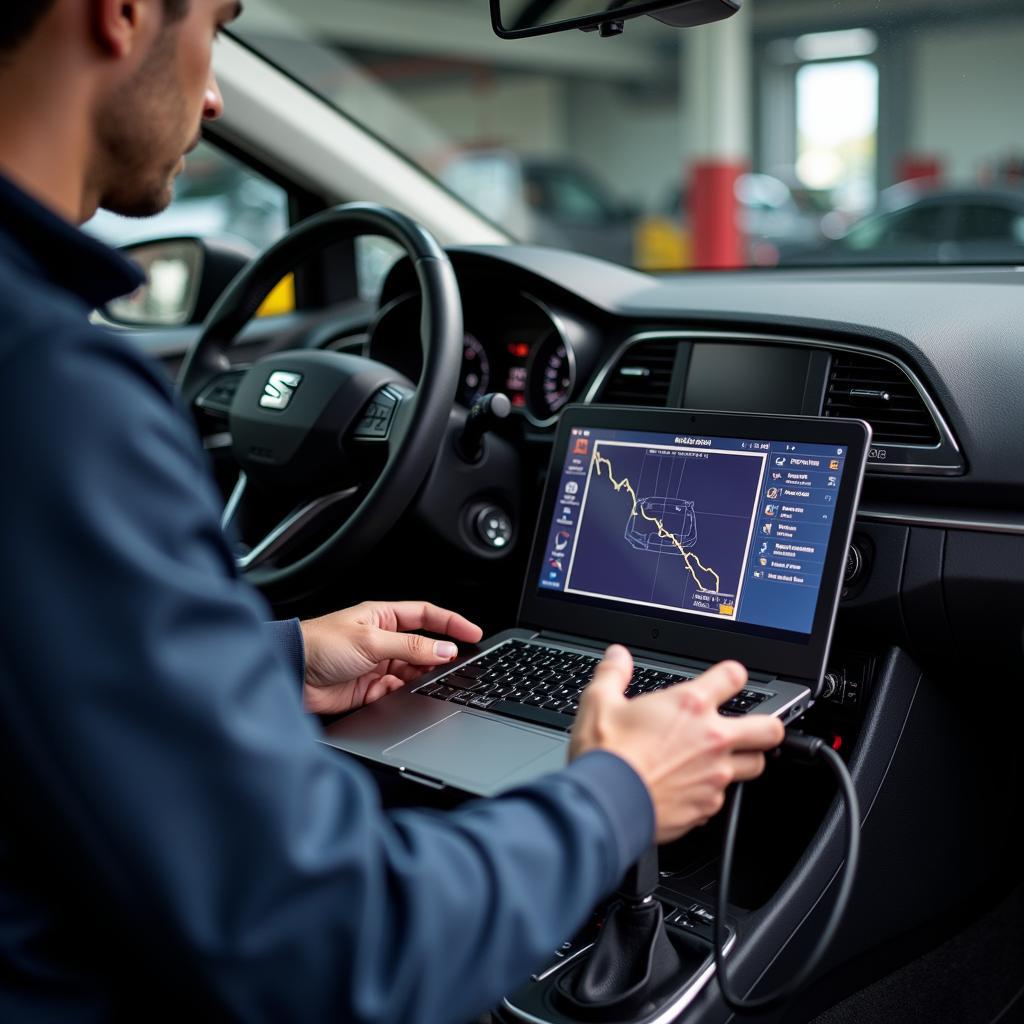The DPF warning light on your Seat Leon is a sign you shouldn’t ignore. This amber light, often resembling an engine block with wavy lines, indicates a problem with your Diesel Particulate Filter (DPF). While a temporary glitch might resolve itself, persistent illumination demands immediate attention to prevent costly repairs. This guide will provide you with a comprehensive understanding of the DPF warning light in your Seat Leon and offer practical solutions to get you back on the road quickly and safely.
Understanding Your Seat Leon’s DPF System
Before delving into troubleshooting, it’s crucial to grasp the basics of the DPF system. Modern diesel vehicles like your Seat Leon employ this system to meet stringent emission standards. The DPF captures and stores soot (particulate matter) produced during combustion. When the soot accumulation reaches a certain level, the system initiates a regeneration process, burning off the collected particles.
Common Causes of the DPF Warning Light
Several factors can trigger the DPF warning light in your Seat Leon:
- Frequent Short Journeys: Consistently driving short distances prevents the DPF from reaching the optimal temperature required for regeneration.
- Faulty Sensors: Malfunctioning sensors, like the DPF pressure sensor, can send inaccurate readings, hindering the regeneration process.
- Blocked DPF: Excessive soot buildup due to driving habits or system malfunctions can clog the filter, impeding exhaust flow.
- Engine Issues: Problems with fuel injection, turbocharger, or EGR system can increase soot production, overwhelming the DPF.
- DPF Regeneration Interruptions: Frequently interrupting the regeneration process can also trigger the warning light.
 Seat Leon DPF Warning Light Location
Seat Leon DPF Warning Light Location
What to Do When the DPF Warning Light Illuminates
When the DPF warning light illuminates, take these steps:
- Consult Your Owner’s Manual: Refer to your Seat Leon’s owner’s manual for specific instructions regarding the DPF warning light.
- Avoid Short Journeys: If possible, take your car for a longer drive on an open road, maintaining a consistent speed. This might help initiate a passive regeneration cycle.
- Check for Other Warning Lights: If other warning lights appear alongside the DPF light, it suggests a potentially more serious issue.
- Seek Professional Diagnosis: If the warning light persists or you suspect a significant problem, contact a qualified mechanic specializing in Seat vehicles.
 Seat Leon Diagnostic Scan
Seat Leon Diagnostic Scan
DPF Warning Light: Ignoring the Risks
Ignoring the DPF warning light can lead to severe consequences:
- Reduced Engine Performance: A clogged DPF restricts exhaust flow, resulting in decreased engine power, sluggish acceleration, and poor fuel economy.
- Expensive Repairs: Prolonged neglect can lead to irreversible damage to the DPF system, requiring costly replacements.
- Vehicle Immobilisation: In extreme cases, the car’s ECU (Engine Control Unit) might initiate a limp-home mode, limiting your driving speed and potentially requiring towing.
“Ignoring a DPF warning light is like ignoring a fever,” says John Miller, a senior automotive technician with over 20 years of experience. “It’s your car’s way of telling you something is wrong, and addressing it promptly can save you a lot of trouble and money down the line.”
Preventing Future DPF Issues in Your Seat Leon
Implementing these preventative measures can help minimize the risk of encountering DPF problems in the future:
- Regular Servicing: Adhering to the manufacturer’s recommended service schedule ensures your car’s DPF system remains in optimal condition.
- Use the Correct Engine Oil: Always use the engine oil specified in your owner’s manual. Using the wrong oil can negatively impact the DPF’s performance.
- Avoid Idling: Excessive idling can lead to increased soot buildup in the DPF.
- Drive Regularly at Higher Speeds: Incorporating occasional drives on highways allows the DPF to reach the required temperature for effective regeneration.
Addressing the DPF Warning Light in Your Seat Leon: Take Action
The DPF warning light in your Seat Leon is a crucial indicator of your car’s health. By understanding its causes and taking prompt action, you can prevent costly repairs and ensure optimal performance. Remember, timely maintenance and informed driving habits can significantly extend the lifespan of your DPF system and keep your Seat Leon running smoothly for miles to come.
Frequently Asked Questions about Seat Leon DPF Warning Light
1. Can I continue driving with the DPF warning light on?
While you might be able to drive for a short period, it’s not advisable. Continued driving with an illuminated DPF warning light can lead to further damage and more expensive repairs.
2. How much does it cost to replace a DPF in a Seat Leon?
DPF replacement costs can vary depending on the model year and the specific Seat Leon variant. However, it’s a significant expense, often ranging from a few hundred to over a thousand pounds.
3. How often does a DPF need replacing?
With proper maintenance and driving habits, a DPF should last the lifetime of the vehicle.
4. Can I clean my Seat Leon’s DPF myself?
While DIY cleaning kits are available, it’s highly recommended to have a professional mechanic clean or replace the DPF. Improper cleaning can damage the sensitive components.
5. How can I tell if my Seat Leon is undergoing DPF regeneration?
You might notice a temporary increase in fuel consumption, a change in engine noise, a slight burning smell, or increased fan operation when the car is parked.
For more information on warning lights in your Seat Leon, you can check out our articles on Seat Leon warning lights, Seat Leon glow plug warning light, Seat Leon dashboard warning signs, Seat Leon engine emissions warning light, and Seat Leon emissions warning light.
